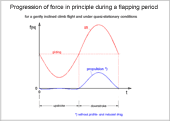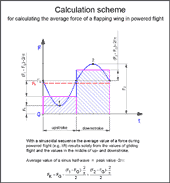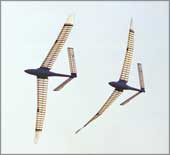Calculation tools
for ornithopter models
Content:
There is no common calculation method for flapping wings. In every source of information different methods are being described.
All Orni calculation tools given below are based on
the calculation method specified in the handbook
How Ornithopters Fly
. Particularly, the power
and the twisting of the wing at stationary flight situations can determinate
with it.
Furthermore, the calculation method permits an approximate quantitative specification of dynamics and aerodynamics of profiled flapping wings, at least. Primarily, the numerical comparison of various factors influencing of flapping wings.
Profiled flapping wings and quasi-stationary flow conditions are presumed. Therefore, calculations only lead to useful results for a fast forward flight with a relatively low flapping frequency (like large birds; please see the description of flying with lift).
The mathematical models are only executable with the respective software applications.
A calculation scheme for the creation of your own calculation program can be found in the Handbook in Appendix D.
1. Orni 1
Simple calculation tool
in particular to describe the wing twisting
The equations of the handbook are used in a small MS-EXCEL calculation tool:
Download Orni 1 version 5.0 (xlsx, with a short instruction, 0.1MB)
This tool primarily allows the calculation of wing twisting at given wing data.
-

- Force progression
in principle
-

- Force calculation scheme for flapping wings
The additional calculation of data of the flying model is highly simplified. The detailed calculation of the force progression during a stroke cycle has been replaced by assuming a sinusoidal progression of the force. Thereby the accurate coupling of stroke motion and twisting remains unconsidered. Only the reference line (such as in gliding flight) and the amplitude of the sine half-wave in the middle of each wing beat are determined. With that, the area under the curve progression or the size of a force is approximately calculable.
2. Orni 2
Mathematical model for ornithopters
The basic calculation method of the handbook How Ornithopters
Fly
is reconstructed step by step. Many of the itemised equations
are generated with accompanying text, diagrams and pictures.
The abidance of the operational range of the lift coefficient of the used airfoil is automatically warranted in the calculation tool. Also, the setting of balance of forces during flight happens in a simple way. Therefore, one can certainly achieve the flight data of the chosen model configuration.
For the construction of a flapping wing model the calculation method describes various force and moment developments at the wing. Furthermore, the required power and - above all - the wing twisting along the span are being calculated.
The calculation tool was written (in German) with the software Mathcad
.
Because of the volume of data and pages it requires a little
familiarisation.

Web Page
for taking a look
PDF file
for printing
Spreadsheet
for Mathcad-user
3. Orni 3
For comparisons in calculation series
This tool is based on the calculation tool Orni 2. Here, gliding and power flights of a flapping wing model can be analysed singly and in series.
To calculate an ornithopter model it is specified by diverse input parameters at first. One of these is defined as an area variable. In the chosen data area one then receives the data of flight and drive, while automatically keeping the data of the airfoil and the balance of forces.
Since there are only a few specifications included, the calculation tool Orni 2 beforehand should be known.
The calculation tool was written with the software Mathcad
(in German).

Web Page
for taking a look
PDF file
for printing
Spreadsheet
for Mathcad-user
Note
The here listed calculation tools are too understood as open source software. Therefore, everybody is enabled to take an insight look in the calculation method. Everyone has the permission to relay, vary and particularly to correct and improve this source code.
4. Comparison of the transport performance of a swan with those of flying models
The flight performance of a mute swan is compared with the performances of a propeller and a flapping wing model.
Download Comparison (xlsx, 28 KB)
The mute swan needs the most energy. Particularly, this is due to the small efficiency of his muscles but not to his way of flying. Instead, the swan has the advantage that his body fat provides a relatively high density of energy storage. With the used calculation tools the flapping wing model is a little bit more effective than the propeller model.
Also the flapping wing model of the handbook is compared with an according propeller model.

